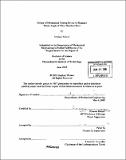| dc.contributor.advisor | Ernesto Blanco. | en_US |
| dc.contributor.author | Weiner, Stephen (Stephen Andrew) | en_US |
| dc.contributor.other | Massachusetts Institute of Technology. Dept. of Mechanical Engineering. | en_US |
| dc.date.accessioned | 2006-05-15T20:42:43Z | |
| dc.date.available | 2006-05-15T20:42:43Z | |
| dc.date.copyright | 2005 | en_US |
| dc.date.issued | 2005 | en_US |
| dc.identifier.uri | http://hdl.handle.net/1721.1/32969 | |
| dc.description | Thesis (S.B.)--Massachusetts Institute of Technology, Dept. of Mechanical Engineering, 2005. | en_US |
| dc.description | Includes bibliographical references (leaf 25). | en_US |
| dc.description.abstract | Working with Gillette Corporation, an automated mechanical testing tool that bent a small flat piece of steel was designed. The design of the tool was an effort to improve upon previous generations of the same tool. It consisted of three main elements; a servomotor, connected to a torque transducer, which was connected to a break device. A thin piece of steel was loaded into the break device and the motor was activated, moving a flipper arm on the device which bent the steel. While bending this piece of steel, the torque transducer would relay torque and angle information to a computer. This information was collected and displayed in Excel as torque versus angle plots, which would show the moment at which the piece of steel was broken. This entire process was automated so that after loading the steel, one click of a button would run one test. Razorblades were primarily bent with the device until they would break, and for this reason, the measuring tool was called the 'blade break test.' The work consisted of designing a robust mechanical system coupling the three devices mentioned above in series. Code was written in Visual Basic that managed all the individual devices in the measuring tool, getting them to work together and linking them with a computer. | en_US |
| dc.description.abstract | (cont.) A user interface was designed with engineers in mind, imbedding automated data collection and representation through Excel. Finally, a manual was created accompanying the device so other engineers could use, troubleshoot, and modify the 'break test.' The result of this project was the creation of a successful measuring instrument with full documentation and functionality. | en_US |
| dc.description.statementofresponsibility | by Stephen Weiner. | en_US |
| dc.format.extent | 25 leaves | en_US |
| dc.format.extent | 1481807 bytes | |
| dc.format.extent | 1480222 bytes | |
| dc.format.mimetype | application/pdf | |
| dc.format.mimetype | application/pdf | |
| dc.language.iso | eng | en_US |
| dc.publisher | Massachusetts Institute of Technology | en_US |
| dc.rights | M.I.T. theses are protected by copyright. They may be viewed from this source for any purpose, but reproduction or distribution in any format is prohibited without written permission. See provided URL for inquiries about permission. | en_US |
| dc.rights.uri | http://dspace.mit.edu/handle/1721.1/7582 | |
| dc.subject | Mechanical Engineering. | en_US |
| dc.title | Design of mechanical testing device to measure break angle of thin, stainless steel | en_US |
| dc.type | Thesis | en_US |
| dc.description.degree | S.B. | en_US |
| dc.contributor.department | Massachusetts Institute of Technology. Department of Mechanical Engineering | |
| dc.identifier.oclc | 62860988 | en_US |
